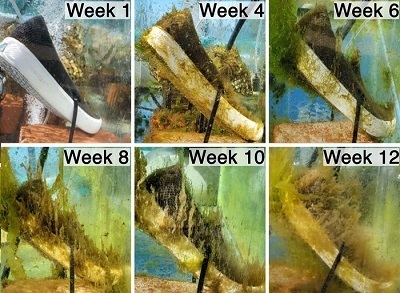Currently, plastic pollution is everywhere. Billions of tons of discarded plastic end up in landfills or float in the sea, where it gradually breaks down into smaller and smaller pieces but never really disappears. It’s one of the biggest environmental problems of our time, and it won’t go away unless we change our plastic habits or develop new materials that are biodegradable.
That’s exactly what scientists at UC San Diego have been doing for the better part of a decade. An interdisciplinary team including biologist Stephen Mayfield and chemists Michael Burkart and Robert “Skip” Pomeroy have developed polyurethane foam made from algae and other biological sources so it can be broken down naturally by the environment agents (bacteria and fungi) biodegrade. Experts have used the foams to make shoes, including flip flops, the world’s most popular footwear, and have tested how they break down in a terrestrial environment. Once buried in soil, the shoes begin to degrade in as little as 16 weeks.

Now, in the new study, the team tested whether these polyurethane foams, made from bio-based monomers, would break down when submerged in seawater. The researchers collaborated with study co-author Samantha Clements, a marine biologist and research diver at the Scripps Institution of Oceanography. They fixed foam and shoe samples on the Ellen Browning Scripps Memorial Dock and monitored their physical and chemical changes using Fourier transform infrared spectroscopy and scanning electron microscopy.
The location of the pier provides a unique opportunity to test materials in natural nearshore ecosystems, which is where waste plastic often ends up. In 2010, researchers estimated that 8 billion kilograms of plastic entered the ocean in a single year, with a significant increase expected by 2025. After plastic waste enters the ocean, it will damage the marine ecosystem, wash ashore as garbage, or migrate to a central location to form a garbage vortex, such as the Pacific Garbage Patch covering an area of more than 1.6 million square kilometers.
The results, now published in the journal Environmental Science, show that those experimental polyurethane materials attached to the docks were quickly attached by various marine organisms and began to degrade in as little as four weeks. Decomposers, primarily bacteria and fungi, break down materials into their original monomers (chemical molecules), which are then used as a source of nutrition. When the researchers identified the microbes that were able to consume the polyurethane samples, they found that these microbes were species commonly found throughout natural marine environments.
Stephen Mayfield, professor in the School of Biological Sciences and director of the California Seaweed Biotechnology Center, said: “No single discipline can solve these universal environmental problems, but we have developed an integrated solution that works on land and now we know it can work in the ocean. Biodegrades. I was surprised to see how many organisms in the ocean colonize these foams. It becomes something like a microbial reef.”
The researchers will continue to seek to develop renewable and sustainable monomers made from biological sources in order to produce polymers for different applications in the future. Their research will also continue to investigate the process of biodegradation and the resulting chemicals. Experts say people are starting to understand the seriousness of the plastic pollution problem and are starting to look for alternatives that are less damaging to nature.
Stephen Mayfield said: “Plastic in the ocean can be broken down into microplastics if not properly handled, and has become a huge environmental problem. We have shown that it is absolutely possible to create high-performance plastic products that can degrade in the ocean. It should go into the ocean, but if it does, this material becomes food for microbes, not plastic litter and microplastics that harm aquatic life.”


